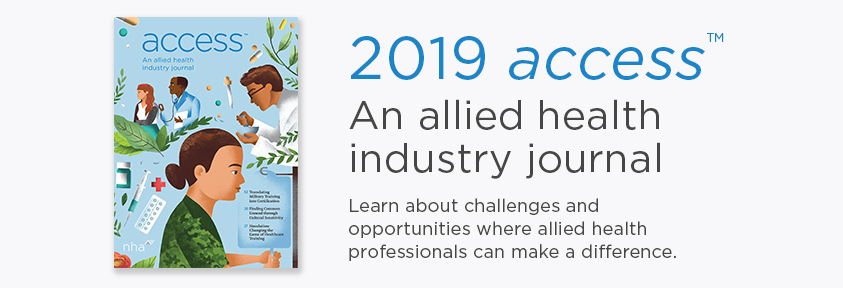Many allied health students are adjusting to remote learning environments as America works to slow the spread of the coronavirus. They are also preparing to enter a field of work that is highly respected, highly needed, and suddenly more dangerous. It's a lot to process, and addressing these students' mental health needs is urgent.
As an educator, you can play a pivotal role in supporting your students during this time of crisis. This post will help you understand why allied health students may be at a particularly high risk of struggling with mental health, how to recognize a student who needs support, and what you can do to help.
Why allied health students are stressed
Student mental health concerns were already on the rise pre-pandemic. More than 60% of college students said they had experienced “overwhelming anxiety” in the past year, and over 40% said they felt so depressed they had difficulty functioning, according to a 2018 report from the American College Health Association.
Those students surveyed were mostly from traditional four-year colleges, but the allied health student population is unique. Some of the demographics of students in vocational programs position them to be even more likely to have mental health challenges. Students in these programs are more likely to:
- Come from a lower socioeconomic background
- Have disabilities
- Get lower grades
- Enter with greater numbers of remedial credits
- Be student parents/expecting parents
Michelle Fynan, PhD, is a Licensed Mental Health Counselor living in Indialantic, Florida who specializes in working with individuals and couples with physical disabilities. She is a university instructor teaching behavioral science online and provides relationship counseling and coaching virtually in private practice. Dr. Fynan says that for some of these students, the pandemic is like adding fuel to the fire:
"These populations in general tend to have a higher risk of mental health concerns. Many of these students have experienced trauma that comes with being members of these groups, so they’re already faced with the struggle that comes with PTSD, anxiety, depression, and often they’re not receiving any type of support when it comes to these mental health concerns. So, when you add on the additional stress of a global pandemic, the isolation, the grief, etc. it’s like adding fuel to the fire."
Signs a student might be struggling
As an educator, it is not your job to act as a therapist. You certainly shouldn't be diagnosing students with mental health disorders or prescribing treatments if that's outside of your professional scope. But as anxiety and mental health challenges continue to increase in the student population—and especially now with the current crisis—the role of educators being in the frontlines has become increasingly important.
Here are some behaviors educators can look for that could indicate a student is experiencing mental health issues, as shared by Dr. Bruce S. Sharkin, a staff psychologist at Kutztown University in Pennsylvania, in his book: College Students in Distress: A Resource Guide for Faculty, Staff and Campus Community.
| Atypical Behaviors (change from the usual) | Unusual Behaviors | Academic Performance Problems |
| Becoming irritable/short-tempered/obsessive | Emails are accusatory, manipulative, sexually inappropriate or threatening | Late assignments from beginning of course |
| Sudden deterioration of quality of work | Discussion post contents are: Bizarre, fantastical, paranoid, disruptive, confused, or show disorientation |
Failing quality of work from beginning of course |
| Abruptly begins turning in late assignments | Student clearly seems out of touch with reality | Not returning emails or phone calls |
| Becoming disrespectful in discussion posts | Not turning in work at all | |
| Stops responding to email | Not re-doing work when given an opportunity | |
| Content of work becomes negative/dark/odd in tone | Ongoing display of anxiety about assignments |
Dr. Fynan says that teachers, even in remote settings, should be identifying at-risk students. Specifically, students who stop participating altogether. "Teachers in an online environment aren’t able to read the room like they can in the classroom, so it’s important to be paying attention to not only what a student is sharing, but what they’re not sharing," she says. "You will have some students who will share their struggles in the online discussion boards or in their submitted assignments. But the biggest indicator of struggle in an online learning environment is the student who just stops participating. They stop submitting work. They stop responding to emails. This is a pretty big indicator that things have become too overwhelming for them and they are trying to cope through avoidance."
"...the biggest indicator of struggle in an online learning environment is the student who just stops participating. They stop submitting work. They stop responding to emails. This is a pretty big indicator that things have become too overwhelming for them and they are trying to cope through avoidance." - Dr. Michelle Fynan
So... what's next? After you've identified some red flags that a student might be struggling, how do you respond? What's appropriate and what's not? And how do you support them from a distance?
4 ways to help students from a distance
The actions you take will vary depending on your institution's policies, procedures, and resources. Here are some examples of ways you can help students cope, even if you're acting in a virtual environment.
1. Share resources that support their health and wellbeing
Some institutions are creating resources to support their students, but resources aren't helpful if students aren't aware of them. Point your students in the right direction, whether that's to a resource created by your institution or something from an industry leader. The Hope Center has a fairly comprehensive guide to help students during the COVID-19 crisis, including information about unemployment, accessing food, and getting mental health support. The CDC has guidance on managing mental health and coping during COVID-19. Simply sharing resources like these with students is a small effort that could make a big impact.
2. Foster virtual classroom connection
Students, especially those living alone, may be struggling with isolation. Social activity has been linked to positive mental health, and your students are likely missing that aspect of the classroom environment. Encourage classroom connection, even when it's outside the classroom. Group message boards, Zoom calls, emails, etc. — the more you can maintain connection now, while of course honoring social distancing directives, the better.
3. Prioritize relationships
Just like maintaining connection with peers, maintaining connection with instructors is also important. In an article published by Teaching Tolerance, one of the expert recommendations for educators supporting students during the COVID-19 crisis is to let relationships be the focus, and even prioritize relationships and well-being over assignments and behavioral compliance.
"It’s important to not take on the role of a therapist, unless you are one. But you don’t have to be a therapist to listen, encourage, and provide support that can be such a necessity right now," says Dr. Fynan. She also recommends further outreach for those at-risk students who stop participating in class. "If they stopped responding to email, it might be time for a phone call," she says.
4. Connect them to outside help
If you have concerns about a student's mental health and wellbeing, you can voice your concern and connect them to professional help. Your institution may have its own health services. If your school is currently offering tele-therapy, you could refer a student to those services, or any other institutional or community support services in your area. *In cases of emergency, encourage students to call 911 or contact the National Suicide Prevention Lifeline at 1-800-273-TALK (1-800-273-8255).
The COVID-19 crisis has put stress on the healthcare system, education system, and arguably every single person in the country—including young and adult learners. Many students were already struggling with mental health issues such as anxiety and depression. These students need to feel supported as a human, not just as an academic student. By knowing the signs to look for and how to respond, educators are in a unique position to help connect students to the support they need during this unprecedented time.




